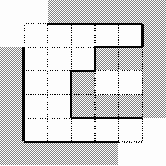ural 1033. Labyrinth dfs
来源:互联网 发布:淘宝收货地址 编辑:程序博客网 时间:2024/05/21 14:06
1033. Labyrinth
Time limit: 1.0 second
Memory limit: 64 MB
Memory limit: 64 MB
Administration of the labyrinth has decided to start a new season with new wallpapers. For this purpose they need a program to calculate the surface area of the walls inside the labyrinth. This job is just for you!
The labyrinth is represented by a matrix N×N (3 ≤ N ≤ 33, you see, ‘3’ is a magic digit!). Some matrix cells contain a dot character (‘.’) that denotes an empty square. Other cells contain a diesis character (‘#’) that denotes a square filled by monolith block of stone wall. All squares are of the same size 3×3 meters.
The walls are constructed around the labyrinth (except for the upper left and lower right corners, which are used as entrances) and on the cells with a diesis character. No other walls are constructed. There always will be a dot character at the upper left and lower right corner cells of the input matrix.

Your task is to calculate the area of visible part of the walls inside the labyrinth. In other words, the area of the walls' surface visible to a visitor of the labyrinth. Note that there's no holes to look or to move through between any two adjacent blocks of the wall. The blocks are considered to be adjacent if they touch each other in any corner. See picture for an example: visible walls inside the labyrinth are drawn with bold lines. The height of all the walls is 3 meters.
Input
The first line of the input contains the single number N. The next N lines contain N characters each. Each line describes one row of the labyrinth matrix. In each line only dot and diesis characters will be used and each line will be terminated with a new line character. There will be no spaces in the input.
Output
Your program should print to the output a single integer — the exact value of the area of the wallpaper needed.
Sample
5........##..#....###.....
198
Problem Author: Vladimir Pinaev
Problem Source: Ural Collegiate Programming Contest '99
Problem Source: Ural Collegiate Programming Contest '99
import java.awt.GridBagConstraints;import java.io.BufferedReader;import java.io.InputStream;import java.io.InputStreamReader;import java.io.PrintWriter;import java.math.BigInteger;import java.util.Arrays;import java.util.StringTokenizer;public class Main {public static void main(String[] args) {new Task().solve();}}class Task{InputReader in = new InputReader(System.in) ;PrintWriter out = new PrintWriter(System.out) ;char[][] grid ;boolean[][] vis ; int[][] dir = {{-1,0},{0,-1},{1,0},{0,1}} ; int n ; boolean cango(int x , int y){ return 0 <= x && x < n && 0 <= y && y < n ; }int dfs(int x , int y){if(vis[x][y]){return 0 ;}vis[x][y] = true ;int sum = 0 ;for(int d = 0 ; d < 4 ; d++){int nx = x + dir[d][0] ;int ny = y + dir[d][1] ;if(! cango(nx, ny)){sum++ ;}if(cango(nx, ny) && !vis[nx][ny]){if(grid[nx][ny] == '#'){sum++ ;}else{sum += dfs(nx, ny) ;}}}return sum ;}void solve(){ n = in.nextInt() ; grid = new char[n][n]; vis = new boolean[n][n] ; for(int i = 0 ; i < n ; i++){ grid[i] = in.next().toCharArray() ; } for(int i = 0 ; i < n ; i++){ Arrays.fill(vis[i] , false) ; } out.println(9*(dfs(0, 0) + dfs(n-1, n-1) - 4)); out.flush();}}class InputReader { public BufferedReader reader; public StringTokenizer tokenizer; public InputReader(InputStream stream) { reader = new BufferedReader(new InputStreamReader(stream), 32768); tokenizer = new StringTokenizer(""); } private void eat(String s) { tokenizer = new StringTokenizer(s); } public String nextLine() { try { return reader.readLine(); } catch (Exception e) { return null; } } public boolean hasNext() { while (!tokenizer.hasMoreTokens()) { String s = nextLine(); if (s == null) return false; eat(s); } return true; } public String next() { hasNext(); return tokenizer.nextToken(); } public int nextInt() { return Integer.parseInt(next()); } public long nextLong() { return Long.parseLong(next()); } public double nextDouble() { return Double.parseDouble(next()); } public BigInteger nextBigInteger() { return new BigInteger(next()); } } 阅读全文
0 0
- ural 1033. Labyrinth(dfs)
- ural 1033. Labyrinth dfs
- ural 1033. Labyrinth dfs
- URAL 1033 Labyrinth(DFS)
- URAL 1033 Labyrinth (DFS)
- URAL.1033 Labyrinth (DFS)
- ural 1033. Labyrinth
- ural 1033 Labyrinth
- Labyrinth (URAL 1033)
- URAL 1033|Labyrinth|搜索
- Ural 1033 Labyrinth(bfs)
- 【Ural 1033】 Labyrinth.(迷宫)
- POJ 2357 Labyrinth [DFS]
- The Labyrinth (dfs)
- 1033. Labyrinth
- URAL - 1145 Rope in the Labyrinth
- CF 616C The Labyrinth(dfs)
- CodeForces 616 C. The Labyrinth(dfs)
- JSONObject需要的jar包
- linux下sudo和su的一些区别
- AI 自动研发机器学习系统,DeepMind 让算法学习强化学习
- Android 打包aar给unity3d使用 项目心得
- http解析XML
- ural 1033. Labyrinth dfs
- 关于php 数组的一些感想心得
- spring main测试
- 【java】jdk1.5新特性详解
- 图灵测试——与Emacs Doctor对话
- 朴素贝叶斯
- 机器学习实验——安装Octave
- DFS的理解,从排列到组合
- 纯html/css练手项目-电商网站


